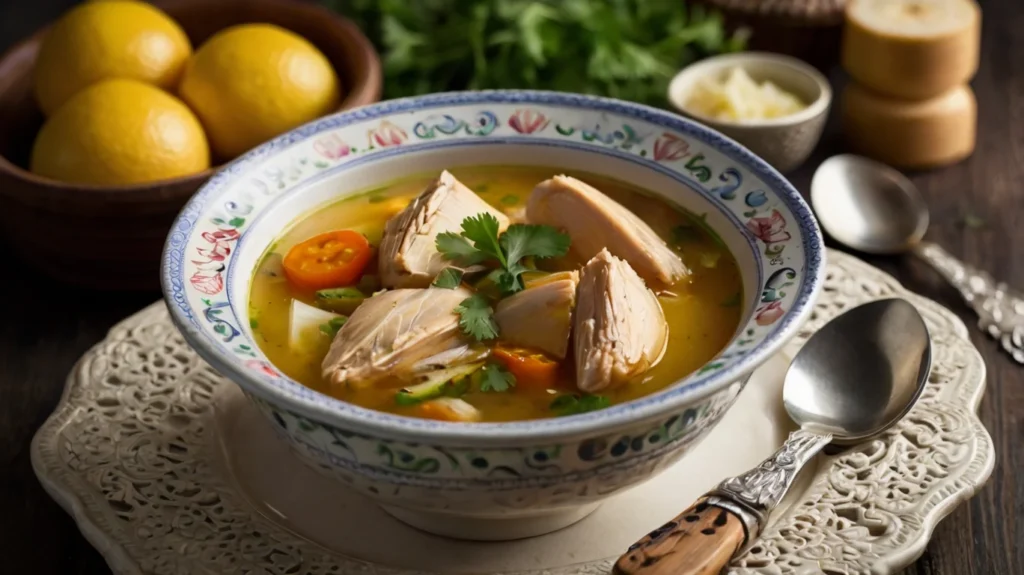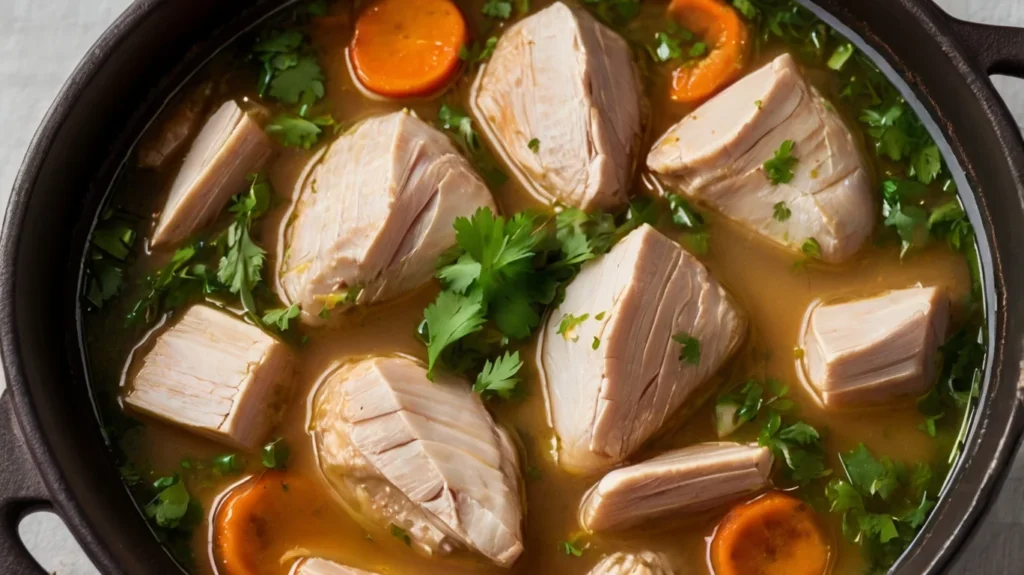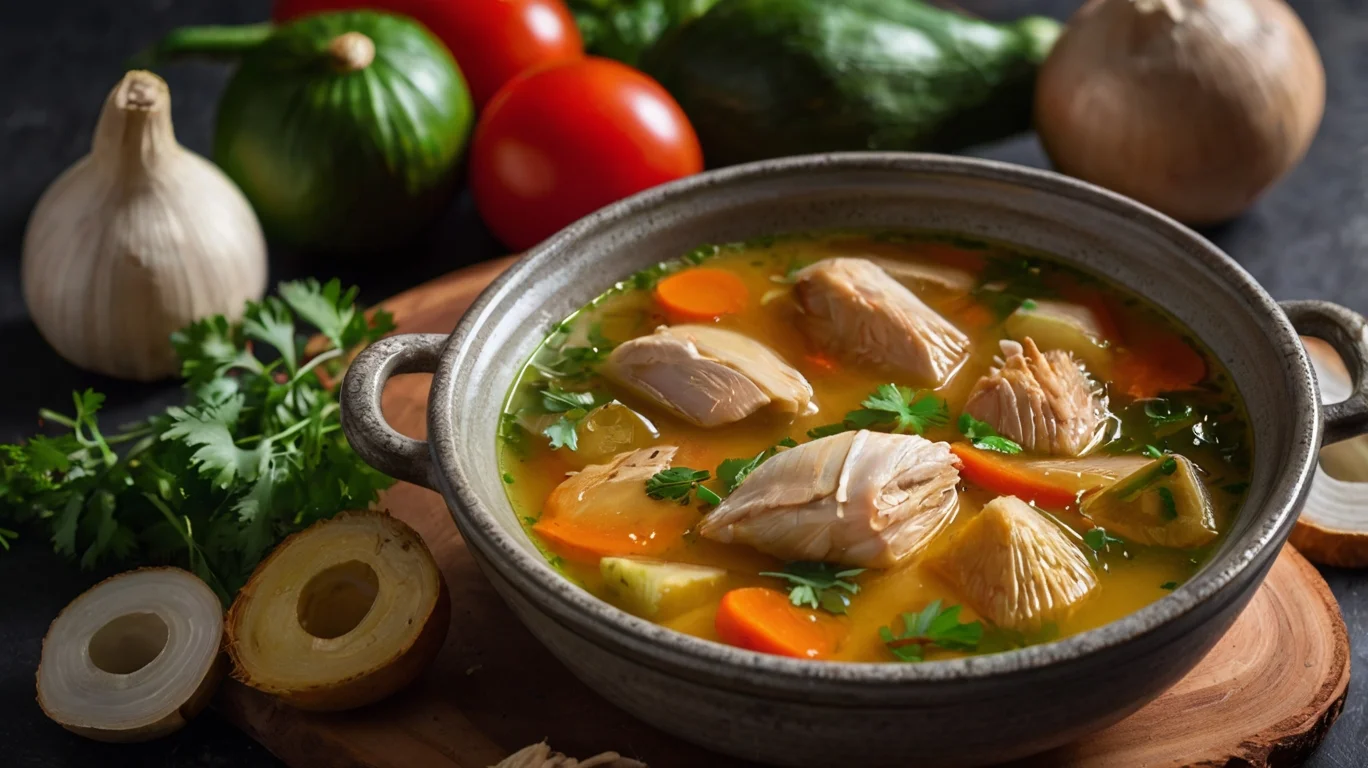Table of Contents
Introduction
Caldo de Pollo, or Mexican chicken soup, is a traditional dish cherished for its simplicity, heartiness, and cultural significance. This classic recipe is a staple in Mexican households, celebrated not just for its delightful flavors but also for its ability to comfort and heal. Translating to “chicken broth” in Spanish, Caldo de Pollo combines tender chicken, vibrant vegetables, and aromatic seasonings to create a rich, flavorful broth that warms the soul.
Its popularity stems from its versatility and restorative qualities. Whether enjoyed as a remedy for the common cold, a wholesome family dinner, or a dish to share during celebrations, Caldo de Pollo holds a special place in Mexican cuisine. Beyond its taste, its nourishing ingredients provide a perfect balance of protein, vitamins, and hydration, making it a go-to comfort food for people of all ages.

Ingredients for Caldo de Pollo
A well-made Caldo de Pollo starts with high-quality, fresh ingredients that contribute to its wholesome flavor and nutritional value. From essential components to optional garnishes, each ingredient plays a role in making this Mexican chicken soup a beloved classic.
Essential Ingredients
- Bone-In Chicken Pieces
- Using bone-in chicken, such as thighs, drumsticks, or a whole chicken cut into parts, adds depth and richness to the broth. The bones release collagen and flavor during simmering, creating a hearty and satisfying base.
- Fresh Vegetables
- Carrots: Add a touch of sweetness and a vibrant orange color.
- Zucchini: Offers a tender texture and subtle flavor.
- Celery: Provides an earthy undertone and aromatic base.
- Corn on the Cob: Adds sweetness and texture, making each spoonful more satisfying.
- Aromatics
- Onion: Essential for a flavorful broth; it serves as a key aromatic ingredient.
- Garlic: Adds depth and a subtle pungency that enhances the overall flavor.
- Seasonings
- Salt and Pepper: Fundamental for seasoning the broth.
- Mexican Oregano: A signature herb that lends a slightly citrusy and floral flavor to the soup.
Optional Add-Ons for Flavor and Texture
- Fresh Cilantro
- Chopped cilantro enhances the soup with its bright, herbaceous aroma.
- Squeezed Lime Juice
- A splash of lime juice before serving adds a refreshing tang that balances the richness of the broth.
- Cooked Rice or Noodles
- For a heartier meal, add cooked white rice or thin noodles to the soup.
- Avocado Slices
- Creamy avocado slices served on top provide a luxurious texture and a mild, nutty flavor.
By combining these essential and optional ingredients, you can craft a Caldo de Pollo that’s not only authentic but also customizable to your personal taste preferences.

Step-by-Step Instructions for Making Caldo de Pollo
Making Caldo de Pollo is a straightforward process that involves preparing fresh ingredients, creating a flavorful broth, and assembling a comforting, hearty soup. Follow these detailed steps to achieve an authentic and delicious dish.
Preparing the Ingredients
- Cleaning and Cutting the Chicken and Vegetables
- Rinse bone-in chicken pieces under cold water and pat them dry with paper towels. Trim any excess fat or skin for a cleaner broth.
- Wash all vegetables thoroughly to remove dirt and debris. Peel carrots and dice them into uniform rounds. Slice zucchini into half-moons, chop celery into even pieces, and cut corn cobs into smaller sections for easy serving.
- Tips for Chopping Vegetables Evenly for Even Cooking
- Aim for consistent sizes when cutting vegetables to ensure they cook evenly. For example, carrots and celery should be similar in thickness to prevent overcooking while maintaining a tender-crisp texture.
Cooking the Soup
- Searing the Chicken for Extra Flavor
- Heat a large pot or Dutch oven over medium-high heat. Add a small amount of oil and sear the chicken pieces until golden brown on all sides, about 5–7 minutes. This step locks in moisture and adds depth to the broth.
- Simmering Chicken with Aromatics to Create the Broth
- Remove the seared chicken and set it aside temporarily. In the same pot, sauté chopped onion and minced garlic until fragrant.
- Return the chicken to the pot and cover it with water (about 8–10 cups). Add salt, pepper, and a generous pinch of Mexican oregano.
- Bring the pot to a boil, then reduce the heat to a simmer. Allow the chicken to cook gently for 30–40 minutes, skimming any foam or impurities that rise to the surface to keep the broth clear.
- Adding Vegetables at the Right Time to Avoid Overcooking
- Once the chicken is tender and cooked through, add the hard vegetables first, such as carrots, celery, and corn. Let these simmer for about 10 minutes.
- Next, add softer vegetables like zucchini. Cook for an additional 5–7 minutes until all vegetables are tender but not mushy.
Final Touches and Serving Suggestions
- Adjusting the Seasoning
- Taste the broth and adjust the seasoning by adding more salt, pepper, or a pinch of Mexican oregano, if needed. A small amount of chicken bouillon powder can also enhance the flavor, if desired.
- Adding Fresh Herbs or Optional Toppings Before Serving
- Stir in freshly chopped cilantro and a splash of lime juice just before serving for a vibrant, refreshing finish.
- Serve the Caldo de Pollo in deep bowls, ensuring each portion has a generous amount of chicken, vegetables, and broth.
- Top with optional garnishes like avocado slices, additional lime wedges, or a sprinkle of chili powder for a touch of heat.
By following these steps, you’ll create a Caldo de Pollo that’s rich, nourishing, and bursting with traditional Mexican flavors. This hearty soup is perfect for any occasion and customizable to suit your preferences.
Tips for Perfect Caldo de Pollo
Making the perfect Caldo de Pollo involves a few simple techniques that elevate this traditional Mexican chicken soup to a restaurant-quality dish. Here are key tips to ensure your soup turns out rich, flavorful, and visually appealing.
Using Bone-In Chicken for a Richer Broth
- Always opt for bone-in chicken pieces, such as thighs, drumsticks, or a whole chicken cut into parts. The bones release collagen and gelatin as they simmer, creating a broth with depth and richness. The meat also remains tender and moist compared to boneless cuts.
How to Skim the Broth for Clarity
- During the initial simmer, foam and impurities naturally rise to the surface of the broth. Use a fine mesh skimmer or a spoon to gently remove this layer periodically. Skimming ensures a clear, clean broth that is visually appealing and free of excess fat.
- For a clearer finish, strain the broth through a fine sieve before adding vegetables back to the pot.
Adjusting the Soup to Your Desired Consistency
- For a heartier soup, reduce the broth by simmering it uncovered toward the end of cooking. Alternatively, you can keep it light and brothy by maintaining the liquid level.
- Add cooked rice, noodles, or extra vegetables to create a thicker, more filling version of Caldo de Pollo based on your preference.
By incorporating these tips, your Caldo de Pollo will achieve the perfect balance of flavor, texture, and presentation.
Variations of Caldo de Pollo
Caldo de Pollo is a versatile dish with endless possibilities for customization. From regional differences across Mexico to creative adaptations influenced by other cuisines, this soup can be tailored to suit a variety of tastes and dietary preferences.
Regional Variations in Mexico
The ingredients and preparation of Caldo de Pollo often vary depending on the region:
- Northern Mexico: Versions from the north might include heartier additions like potatoes or chayote, reflecting the region’s preference for more robust meals.
- Central Mexico: This area often features the classic combination of chicken, carrots, zucchini, and corn, with fresh herbs like cilantro added for a burst of flavor.
- Southern Mexico: In southern states, you may find Caldo de Pollo infused with local spices such as epazote or enriched with masa dumplings for a unique texture.
Popular Global Twists
- Adding Local Spices or Grains from Other Cuisines
- Incorporate quinoa, barley, or wild rice for a nutritious twist.
- Experiment with spices like turmeric, ginger, or curry powder for an international flavor profile.
- Vegetarian or Vegan Adaptations
- Replace chicken with hearty vegetables such as squash, mushrooms, or jackfruit.
- Use vegetable broth infused with herbs and spices to replicate the depth of flavor found in traditional versions.
These variations showcase the adaptability of Caldo de Pollo, making it a soup that transcends borders while staying true to its comforting roots.
Nutritional Benefits of Caldo de Pollo
Caldo de Pollo is not only a comforting dish but also a highly nutritious one, offering a balance of essential nutrients while remaining light and satisfying.
Rich in Protein and Vitamins
The chicken provides a high-quality source of protein, essential for muscle repair and overall body function. The assortment of vegetables, such as carrots, zucchini, and celery, contributes a variety of vitamins and minerals, including vitamin A, vitamin C, and potassium, promoting immune health and energy.
Hydrating and Restorative Properties
The broth serves as an excellent source of hydration, especially when infused with electrolytes like sodium and potassium from the vegetables and seasonings. It is a go-to remedy for colds and flu due to its soothing and warming qualities.
Low-Calorie Yet Filling Meal
Despite its hearty nature, Caldo de Pollo is relatively low in calories, making it an ideal option for those seeking a satisfying meal without overindulging. The combination of protein, fiber, and water content keeps you full while supporting overall health.
Enjoying a bowl of Caldo de Pollo is as nourishing as it is delicious.
FAQs
How long can caldo de pollo sit out?
Caldo de Pollo, like any cooked food, should not sit out at room temperature for more than 2 hours to prevent bacterial growth. If the ambient temperature is above 90°F (32°C), the time reduces to 1 hour. Refrigerate or freeze leftovers promptly to ensure safety.
Why is caldo de pollo good when sick?
Caldo de Pollo is a classic remedy when sick because it is hydrating, easy to digest, and packed with nutrients. The warm broth soothes the throat, the protein from chicken aids in recovery, and the vegetables provide essential vitamins to support immune function.
How do you know when chicken soup is done?
Chicken soup is done when the chicken is fully cooked (internal temperature of 165°F/74°C), tender, and easy to shred. The vegetables should also be fork-tender but not mushy, indicating they’ve absorbed the flavors without overcooking.
How long does caldo de pollo last in the fridge?
Properly stored in an airtight container, Caldo de Pollo can last in the refrigerator for 3 to 4 days. Reheat thoroughly before serving, ensuring it reaches at least 165°F (74°C).
Can you boil bacteria out of soup?
Boiling soup can kill most bacteria, but some, like heat-resistant toxins produced by Clostridium botulinum, are not destroyed by boiling alone. It’s critical to follow proper food safety practices, like refrigerating promptly, to prevent contamination.
How fast can soup go bad?
Soup can spoil quickly if left at room temperature for more than 2 hours. Signs of spoilage include an off smell, sour taste, or unusual texture. Refrigeration slows bacterial growth, keeping it safe for a few days.
Conclusion
Caldo de Pollo is more than just a soup; it’s a culinary tradition that embodies comfort, nourishment, and versatility. Its rich, flavorful broth, tender chicken, and vibrant vegetables come together to create a dish that is as satisfying as it is wholesome. Whether enjoyed as a remedy for the common cold, a hearty family meal, or a way to reconnect with Mexican culture, Caldo de Pollo holds a special place in kitchens and hearts around the world.
One of the most appealing aspects of Caldo de Pollo is its adaptability. For instance, consider trying alternative preparations, like those found in smoked chicken drumsticks, or compare its heartiness to a classic beef stew. The versatility of chicken, as highlighted in the perfect roast chicken, allows you to experiment with flavors and techniques.
To complete the meal, you can pair your soup with a refreshing side dish like a Caesar salad or explore other comforting soups such as chicken noodle soup. These additions make Caldo de Pollo part of a broader culinary experience.
We encourage you to try making Caldo de Pollo at home. Experiment with flavors, add your favorite toppings, or make it your own with local ingredients. This comforting and nourishing soup is more than just a recipe—it’s an experience that warms both body and soul. So grab a pot, gather your ingredients, and enjoy the timeless joy of Caldo de Pollo.

